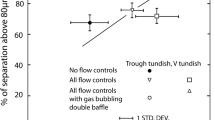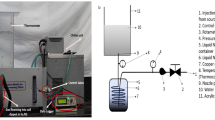Abstract
New types of furniture (also termed as flow modifiers or baffles) were incorporated in industrial scale, slab and bloom casting tundish systems with an aim to reduce residual metal loss (i.e., tundish skull) at the end of sequence casting. To this end, water model experiments were carried out in which, slag vortexing phenomena during emptying of tundish was studied embodying different types of furniture into existing tundish designs. These in general indicate that a wedge shaped bottom together with an embedded pouring box applied in conjunction have the potential to reduce tundish skull and improve yield losses significantly. In addition, limited residence time distribution measurement experiments were made to investigate metallurgical performance of modified design tundish systems. These indicate that deployment of new furniture with minor design modifications, despite contributing to a reduction in tundish capacity (10–12%), do not influence metallurgical performance of steelmaking tundish systems to any significant extent. Accordingly, designs of currently employed slab (32 and 37 tonnes capacity respectively) and bloom casting tundish (10 and a 17 tonnes capacity respectively) systems were modified in four different steel mills and plant trials conducted to assess the extent of yield improvement. Significant improvements in yield losses, to the extent of 50–60%, have been confirmed by the industry during sequence casting.










Similar content being viewed by others
Notes
An exterior well below the tundish nozzle, as is well known, allows far more effective emptying of a tundish and thereby reduces the amount of residual steel, leading to smaller amount of skull. Such a modification cannot be readily adapted to already existing situations, since creation of a well below the tundish nozzle would tend to extend the submerged entry nozzle (SEN) much below its designed level of submergence, affecting continuous casting operation adversely. Thus, if a well is to be incorporated in an existing tundish, redesigning of SEN would be a pre-requisite!
In isothermal flows there is no temperature gradient and Richardson number therefore looses its relevance in such context. Under steady flow in tundish, the slag layer is practically stagnant as a result of such interfacial phenomena can be ignored and Weber number similarity disregarded entirely. Finally, in reduced scale water modeling both Reynolds and Froude number similarity cannot be maintained simultaneously [10]. Moreover, viscous flows are less important in the bulk of tundish where flow is generally known to be turbulent. As a consequence, the isothermal steady flow period in tundish is assumed to be essentially Froude dominated.
As the bath depth recedes, disturbances at the upper, two fluid interface are produced which were found to be highly stochastic. At times, such disturbances manifested as a funnel vortex having a life time that was rather small. In this work, this phenomenon of intermittent vortex formation has been termed as “vortex initiation”. As the bath depth continued to fall further and went down to a critical level, a stable slag vortex was seen to form leading to continuous entrainment of the upper phase fluid through the tundish nozzle. Stable slag vortex that did not disappear once formed, has been termed as a “fully developed vortex”. It is this latter type that has been considered significant and representative of slag entrainment phenomena in continuous casting of steel.
The dimensionless thickness of the upper phase was similar to that generally encountered in the industry.
Each plant has several tundish of the same design and capacity. At any instant of time, a few of these are used in the continuous casting circuitry while the remaining ones are heated, repaired or re-lined. At the end of a sequence, a tundish is generally removed from the continuous casting bay and is de-skulled. Following repair, etc. the same is recycled.
Worked out on the basis of a 50 T heat size, 0.6 MMTPA rated capacity and 340 un-interrupted working days in a year.
References
Hammerscmid P, Tacke K-H, Popper H, Weber L, Dubke M, and Schwerdtfeger K, Ironmak Steelmak 11 (1984) 332.
Dubke M B, and Schwerdtfeger K, Ironmak Steelmak 17 (1990) 184.
He O, ISIJ Int 33 (1993) 343.
Sankarnarayanan R, and Guthrie R I L, Ironmak Steelmak 29 (2002) 147.
Solhed H, Jonsson L, and Jonsson P, Metall Mater Trans 33B (2002) 173.
Jin Gang L, Hue Cheng Y, Liu L, and Xin Hua W, J Iron Steel Res 18 (2006) 187.
Davila O, Garcia-Demedices L, and Morales R D, Metall Mater Trans 37B (2006) 71.
Rudman M, Int J Numer Methods Fluids 24 (1997) 671.
Mazumdar D, and Guthrie R I L, ISIJ Int 39 (1999) 525.
Mazumdar D, Yamanoglu G, Sankarnarayanan R, and Guthrie R I L, Steel Res 66 (1995) 14.
Mazumdar D, and Evans J W, Modeling of Steelmaking Processes, CRC Press, Boca Raton, FL, USA (2009).
Anand S, Experimental and Theoretical Studies of Residence Time Distributions in Different Tundish Designs, M Tech Thesis, Department of Materials Science and Engineering, Indian Institute of Technology, Kanpur (2008).
Fluent 6.3 Instruction Manual, www.fluent.com, 2008–2010.
Satish Kumar D, Mazumdar D, Reddi Prasad B, Patil S P, Sarkar A, Mahapatra P C, and Ranjan M, Indian Patent Appl. No: 1397/MUM/2008, 3 July 2008.
Sahai Y, and Emi T, ISIJ Int 36 (1996) 667.
Author information
Authors and Affiliations
Corresponding author
Rights and permissions
About this article
Cite this article
Mazumdar, D., Singh, O.P., Dutta, J. et al. Reduction of Tundish Skull and Yield Improvement in Steel Plants Through Physical Modeling of Steelmaking Tundish Systems. Trans Indian Inst Met 64, 593–605 (2011). https://doi.org/10.1007/s12666-011-0067-8
Received:
Accepted:
Published:
Issue Date:
DOI: https://doi.org/10.1007/s12666-011-0067-8




